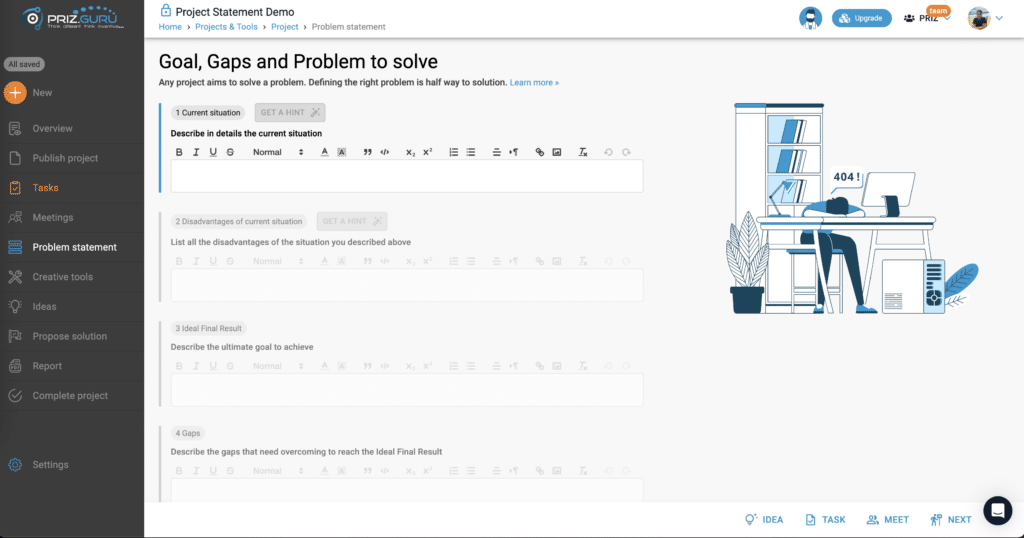Defining a problem statement is an extremely important step in the journey of solving any issue, whether in business, technology, or personal projects. A well-crafted problem statement sets the stage for focused efforts, guiding research, and strategic development. It acts as a beacon, illuminating the path toward the ultimate goal by clearly outlining the gap between the current reality and the desired outcome. In this article, we will explore the steps of defining a proper problem statement, delve into its key components, and provide practical examples to help you with the process using the PRIZ platform.
First, I want to put the correct definition in place, so we all understand what is the goal of the problem statement and further understand why it is so important.
I found many examples on the web defining the problem statement. The one I liked from A Guide to the Project Management Body of Knowledge (PMBOK Guide) can be summarized as follows:
A problem statement is a concise description of an issue to be addressed or a condition to be improved. It identifies the gap between the current state and the desired state of a process or product. The problem statement should include the problem’s context, the impact of the problem, and the criteria for a successful solution. It serves as the foundation for any project by focusing the team’s efforts and guiding the research and development process.
I wanted, however, to simplify it a bit.
A problem statement is a clear and concise description of an issue that needs to be addressed. It identifies the gap between the current state and the desired state, providing a foundation for research and problem-solving efforts. It typically includes the problem’s background, its impact, and the criteria for a successful solution.
With the definition in place, it’s important to understand why defining a proper problem statement is so important. There are many reasons for this, but here are a few of the most critical ones
Before we dive into building the problem statement, it’s important to reiterate the difference between failure and the problem.
Failure is what we can see, hear, or feel. The problem is what we need to do differently as a result of the failure.
For example, the failure might be low efficiency on a production line. This can lead to different problems such as low customer satisfaction, reduced sales, high production costs, and more.
Failures cannot be fixed, but problems can be solved. A failure is the origin of several problems and indicates that problems exist. The worst situation is when people (engineers) try to solve the failure itself. We should analyze the failure, identify the problems, analyze those problems, make the right choices, and correctly formulate the problem statement.
In many processes and templates that organizations and teams create over time, it’s common to have a single field for the problem statement. While it’s great that these processes encourage defining the problem to solve, there’s little done to help engineers actually define it. This is one reason why this phase is often not properly done or is ignored altogether.
At PRIZ, we believe the problem statement is critical enough, so we invested the time to research and build the process into our Engineering Thinking Platform.
Here is the 5-step process for defining the problem statement, which our research shows is the most efficient and produces the best results when a team focuses on resolving a challenge, especially a complex one.

As the definition states, we first need to clearly identify the current state. In the PRIZ Platform, we call this the Current Situation to make it more generic.
For this example, we chose a random manufacturing problem.

At this phase, we need to understand why the current situation is undesirable. It’s important to note that different people and contexts may have different disadvantages. In this example, if someone doesn’t care about this production line or its output, they might not see any disadvantages. That person might not even consider it a problem.
The definition of disadvantages is subjective to the person, the team, the case, etc.

The next step is defining the Ideal Final Result. In simple terms, what are we trying to achieve?
This example is quite straightforward: “Production line’s efficiency should be at least 90%.”

Now that we have identified the current state and the desired state, the gaps are what prevent us from reaching our goal. We can narrow down these gaps. In this case, it is very clear and has been mentioned before: frequent machine breakdowns and workflow bottlenecks are stopping us from achieving 90% production line efficiency.
Gaps should state concisely and clearly what they are.

Finally, we have all the information needed to define the problem statement. In the PRIZ Platform, we call it a Problem to Solve.
When we combine all the collected knowledge, it might look something like this:
The production line is currently operating at 70% efficiency due to frequent machine breakdowns and workflow bottlenecks. These issues cause delays in order fulfillment and increase operational costs. The desired production efficiency is at least 90%.

That’s it. Here are a few good examples of problem statements. Keep in mind, there is no strict rule about how a problem statement should look. The important part is that it clearly identifies the gap between the current state and the desired state, providing a foundation for research and problem-solving efforts.